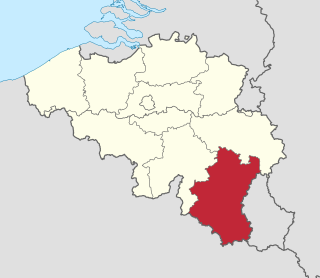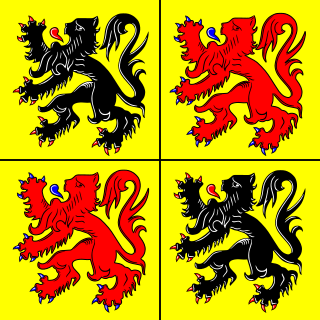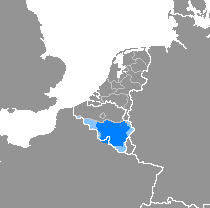
Luxembourg, also called Belgian Luxembourg, is the southernmost province of Wallonia and of Belgium. It borders on the country of Luxembourg, France, and the Belgian provinces of Namur and Liège. Its capital is Arlon, in the south-east of the province.

Liège is the easternmost province of Wallonia and Belgium.

West Flanders is the westernmost province of the Flemish Region, in Belgium. It is the only coastal Belgian province, facing the North Sea to the north. It has land borders with the Netherlands to the northeast, the Flemish province of East Flanders to the east, the Walloon province of Hainaut in the southeast and France to the west. Its capital is Bruges (Brugge). Other important cities are Kortrijk in the south and Ostend on the coast, Roeselare and Ypres (Ieper). The province has an area of 3,125 km² which is divided into eight administrative districts (arrondissementen) containing 64 municipalities.

Hainaut and historically also known as Heynowes in English, is a province of Wallonia and Belgium.

The Prix de Rome or Grand Prix de Rome was a French scholarship for arts students, initially for painters and sculptors, that was established in 1663 during the reign of Louis XIV of France. Winners were awarded a bursary that allowed them to stay in Rome for three to five years at the expense of the state. The prize was extended to architecture in 1720, music in 1803, and engraving in 1804. The prestigious award was abolished in 1968 by André Malraux, the Minister of Culture.
The Minister of Commerce was a cabinet member in the Government of France. The position sometimes included responsibility for other government departments such as Public Works, Interior, Agriculture and Posts, Telegraphs and Telephones. The position has largely been merged today into the expanded Ministry of the Economy, Finance and Industry.

The Minister of Worship is a cabinet member in the Government of France responsible for overseeing the French government's relationship with religions. An area of particular attention was the Roman Catholic Church's role in public education, and the portfolio of Minister of Worship was frequently combined with "Minister of Public Education". After the founding of the Third Republic in 1871, the Jules Ferry laws and the 1905 law on the separation of the State and the Church, the Minister of Worship was combined with the Minister of Interior. Thus, it is in that quality that the previous Interior Minister Nicolas Sarkozy created in 2003 the CFCM.
The Liberal Party was a Belgian political party that existed from 1846 until 1961, when it became the Party for Freedom and Progress, Partij voor Vrijheid en Vooruitgang/Parti de la Liberté et du Progrès or PVV-PLP, under the leadership of Omer Vanaudenhove.
La Société zoologique de France, founded in 1876 by Aimé Bouvier, is a scientific society devoted to Zoology. It publishes a bulletin and organises the Prix Gadeau de Kerville de la Société zoologique de France.
This is the list of Belgian ministers of Justice.

![]()
















